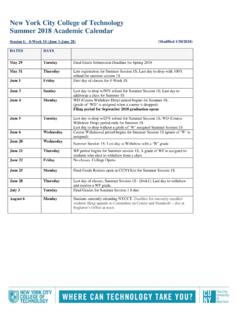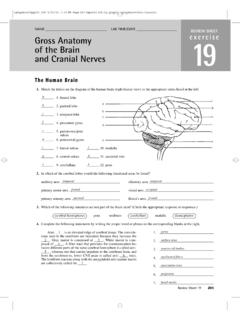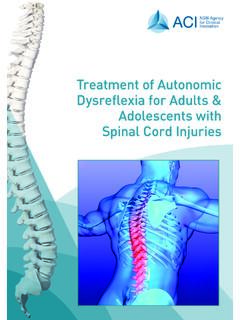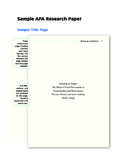Transcription of ANATOMY AND PHYSIOLOGY I (BIO 2311) SYLLABUS
1 ANATOMY AND PHYSIOLOGY I ( bio 2311 ) SYLLABUS NEW YORK CITY COLLEGE OF TECHNOLOGY The City University Of New York School of Arts and Sciences Department of Biological Sciences Course Information Course title: ANATOMY and PHYSIOLOGY 1 (Lecture and Laboratory) Course code: BIO2311 and BIO2311L Credit Hours: 4 credit hours 3 hours lecture and 3 hours lab per week for 15 weeks Prerequisite: BIO 1101 or equivalent, and CUNY certification in reading and writing. Coreq: BIO2311 Lab. Text and Other Materials: Lecture Fundamentals of ANATOMY & PHYSIOLOGY 11th ed.
2 , 2015, by F. Martini, Nath and Bartholomew; Pearson Lab Human ANATOMY and PHYSIOLOGY Laboratory Manual (Fetal Pig), 12th ed., 2014, by E. N. Marieb and L. A. Smith; Pearson Lab coat and dissecting instruments. Course Description: This is the first part of a two semester course. Grading Procedure (see Grading Policies for details) Lecture: 60% of the final grade (based on 3-4 one hour exams) Lab: 40% of the final grade (based on minimum of 4 quizzes and 2 practical exams). Course Coordinators Vasily Kolchenko, Olufemi Sodeinde Lecture Instructor: Phone & Email: Lab Instructor: Phone & Email: 1 Course Description This is the first part of a two semester course.
3 It covers the ANATOMY and PHYSIOLOGY of the cell, tissues, integumentary, skeletal, muscular and nervous systems. Prerequisites: BIO 1101, College-level general biology course with lab or a score of 85 or above on the New York State Regent s exam and CUNY proficiency in reading and writing. Student Learning Outcomes Students will: 1. Describe the levels of organization of living organisms. 2. Define and explain basic medical terminology as related to the ANATOMY and PHYSIOLOGY . 3. Understand, identify, and describe the various regions, sections, positions and directions of the body.
4 4. Identify and describe the major body cavities and their subdivisions. 5. Understand and describe the ANATOMY and PHYSIOLOGY of the cell, tissues, skeletal, muscular, nervous and integumentary system. 6. Define and describe mechanisms involved in homeostatic regulation of the body. 7. Develop basic dissection techniques relevant to the field of ANATOMY . 8. Develop basic laboratory techniques relevant to the field of PHYSIOLOGY . Gen Ed Common Core Learning Objectives (Goals) Students will: 1. Value knowledge and learning. 2. Use the arts, sciences and humanities as a forum for the study of values, ethical principles, and the physical world.
5 3. Employ scientific reasoning and logical thinking. 4. Gather, interpret, evaluate, and apply information discerningly from a variety of sources. 5. Acquire the tools for lifelong learning how to learn, how they learn, knowledge of resources. 6. Engage in an in-depth, focused, and sustained program of study. 7. Pursue disciplined, inquiry-based learning in the major. 8. Derive meaning from experience as well as gather information from observation. 9. Understand and employ both quantitative and qualitative analysis to describe and solve problems, both independently and cooperatively.
6 10. Understand and appreciate the range of academic disciplines and their relationship to the fields of professional and applied study. 11. Demonstrate intellectual honesty and personal responsibility. CUNY Common Core Learning Outcomes Students will: 1. Identify and apply the fundamental concepts and methods of a life or physical science. 2. Apply the scientific method to explore natural phenomena, including hypothesis development, observation, experimentation, measurement, data analysis, and data presentation. 3. Use the tools of a scientific discipline to carry out collaborative laboratory investigations.
7 4. Gather, analyze, and interpret data and present it in an effective written laboratory or fieldwork report. 5. Identify and apply research ethics and unbiased assessment in gathering and reporting scientific data. 2 Laboratory Schedule Week 1 Organization of the Human Body Review Metric system (xiv xx) Ex. 1 - The Language of ANATOMY Anatomic Position.
8 Body Orientation and Direction, Body Planes and Sections, Surface ANATOMY , Body Cavities, Serous Membranes Ex. 2 -Organ Systems Overview. 1 -10 15 - 24 Week 2 The Microscope and Its Uses Ex. 3 - Care and Structure of the Compound Microscope, Magnification and Resolution, Use of the. Microscope Preparation of a Wet Mount, use protozoa. Cell Structure and Division Ex. 4 -The Cell: ANATOMY and Division Cell Division, compare whitefish blastula and onion root tip; Meiosis. Video Mitosis and Meiosis 27 34 39 - 48 Week 3 Transport Mechanisms Ex. 5 The Cell: Transport Mechanisms and Cell Permeability Passive Transport: Diffusion, Filtration; Active Transport 53 - 62 Week 4 Basic Tissues of the Body Ex.
9 6 -Classification of Tissues Epithelial Tissue; Connective Tissue Ex. 7 -The Integumentary System 67 86 93- 102 Week 5 The Skeletal System I Ex. 8 - Bone Classification and Structure Bone Markings and Classification Gross ANATOMY of a Typical Long Bone Microscopic Structure of Compound Bone Chemical Composition of Bone Ex. 10 - The Appendicular Skeleton 107 115 149- 162 Week 6 The Skeletal System -II Ex. 9 -The Axial Skeleton The Skull; The Vertebral Column; The Thoracic Cage Ex. 9 -The Fetal Skull 121 140 140 Week 7 The Skeletal System III Ex. 11 Articulations and Body Movements Fibrous, Cartilaginous, and Synovial Joints; Demonstrating Movements of Synovial Joints Review for Bone Practicum 171 - 184 3 Week 8 Organization and Activity of Muscle Tissue Ex.
10 6 - Histology of the Muscle Types Ex. 13 Gross ANATOMY of the Muscular System Classification of Skeletal Muscles and Identification of the superficial muscles of the body BONE PRACTICUM 83 85 199 - 228 Week 9 Ex. 12 -Microscopic ANATOMY , Organization and Classification of Skeletal Muscle Ex. 14 Skeletal Muscle PHYSIOLOGY : Action Potential; Contraction Use the Physio-EX CD 189 194 237 - 252 Week 10 Histology of Nervous Tissue Ex. 6 - Histology of Nerve Ex. 15- The Histology of Nervous Tissue, Neuron ANATOMY ; Classification; Structure of a nerve 82- 83 257 - 264 Week 11 The Nervous System Ex.









